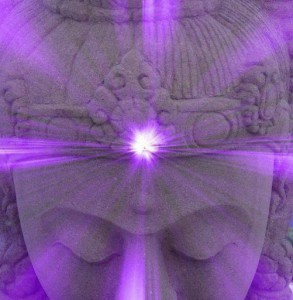(Yampolsky)
“The samādhi of oneness is straightforward mind at all times, walking, staying, sitting, and lying. The Ching-ming ching says: ‘Straightforward mind is the place of practice; straightforward mind is the Pure Land.’ Do not with a dishonest mind speak of the straightforwardness of the Dharma. If while speaking of the samādhi of oneness, you fail to practice straightforward mind, you will not be disciples of the Buddha. Only practicing straightforward mind, and in all things having no attachments whatsoever, is called the samādhi of oneness.The deluded man clings to the characteristics of things, adheresto the samādhi of oneness, [thinks] that straightforward mind is sitting without moving and casting aside delusions without letting things arise in the mind. This he considers to be the samādhi of oneness. This kind of practice is the same as in insentiency the cause of an obstruction to the Tao. Tao must be something that circulates freely; why should he impede it? If the mind does not abide in things the Tao circulates freely; if the mind abides in things, it becomes entangled . If sitting in meditation without moving is good, why did Vimalakirti scold Śāriputra sitting in meditation in the forest? “Good friends, some people teach men to sit viewing the mind and viewing purity, not moving and not activating the mind, and to this they devote their efforts. Deluded people do not realize that this is wrong, cling to this doctrine, and become confused. There are many such people. Those who instruct in this way are, from the outset, greatly mistaken.”
We have come to a critical junction in terms of meditation in conjunction with diverse Ch’an and Zen traditions. Of course, within the dominant brand of contemporary Sōtō Zen Buddhism, the entrenched Dogenized rubric of sitting is paramount. In the course of this study of the Platform Sutra, this is most interesting as Sōtō Zen has apparently adopted a rubric that is clearly at odds with the dominant brand of Southern School Ch’an Buddhism. The influence of Shen-hui’s school is most obvious in this passage: “to insist that sitting-meditation, wherein one’s emphasis is placed exclusively on the formal means (i.e., the rubric of sitting) of quieting mind is pure delusion; those who adhere to this type of doctrine are bewildered and hence create abject confusion in the minds of others; in so doing, they are in grave error.” In stark contrast to this confounded obsession with the rubric of sitting, there has developed within mystical-schools of Ch’an Buddhism a most singular approach to the nature of meditation; one that is in league with what is presented at the beginning of this passage: “samādhi of oneness is straightforward mind at all times…whether walking, staying, sitting, and lying.” An assessment of the samādhi of oneness is as follows:
The Platform Sutra emphasizes that the oneness of samādhi is not dependent upon any one meditation technique or even upon any particular object of meditation. Indeed, there is a deep detachment from any external and formal modes that would hinder the main emphasis that needs to occur, and that is the essential-inner absence of all phenomenal marks, save for Mind’s Own imageless samādhi of suchness. This is fully revealed in the Awakening of Faith:
“Through this samādhi, you understand that the Dharmadhātu has only one mark; in other words, that the Dharma-body (Dharmakaya) of the Buddhas is the same as the body of sentient beings and that there is no duality between them. Hence this expression “one-mark samādhi”. You must know that suchness is the basis of the samādhis. If you practice it, you can generally produce an infinity of samādhis.” (Relayed by Bernard Faure in his article, “ One-Practice Samādhi in Early Ch’an”; a chapter in “Traditions of Meditation in Chinese Buddhism”, as edited by Peter N. Gregory)
This is truly remarkable as singularly translated as being “one-pointedness of mind in deep samādhis”: the markless-mark of the Dharmadhātu is the sole contemplation in the Self-Realization of the Dharmakayic-Mind. The whole emphasis here is on that Absolute One-Pointedness of Mind…Mind free of any projections and pointing-directly at Its own Primordial Stature. There are singular Dhyana-Techniques that empower entry into this deep-one-pointedness samādhis, like Recollecting and Contemplating exclusively upon the Dharmadhātu in all situations, as the sutra says “whether walking, staying, sitting and lying.” Another is utilizing Tozen’s “Black-Dragon-Eye Mandala” (as referenced in numerous blog posts here), indeed a great focal-tool for that centered single-mindedness (Biguan) of Mind.
Good friends, how then are meditation and wisdom alike? They are like the lamp and the light it gives forth. If there is a lamp there is light; if there is no lamp there is no light. The lamp is the substance of light; the light is the function of the lamp. Thus, although they have two names, in substance they are not two. Meditation and wisdom are also like this.
This passage nicely compliments Hui-neng’s former unionized account of Dhyana/Prajñā with this present Samādhi of Oneness. The Samādhi of One-pointedness of Mind can be likened unto a single beam of Light that pierces through all defiled sensate phenomena directly (regardless of the surrounding circumstances) into the Heart of Tathatic Wisdom Itself.

